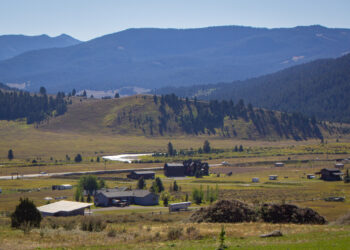By Benjamin Alva Polley EBS COLUMNIST
One hundred years ago, around 1925, people in areas with very dark skies, far from significant light pollution, could see several thousand stars with the naked eye. Under ideal conditions, this number could reach up to 4,500 stars in one hemisphere on a given night. The Milky Way galaxy was even visible from places like Central Park, highlighting the darker skies of that time.
Fast forward a century, and seeing the Milky Way has become a challenge unless you’re in a super remote location. Even in sparsely populated areas like Montana and Wyoming, views of the Milky Way are not guaranteed. In fact, 80% of the U.S. population can no longer see it.
As the human population in the West has grown, increased light pollution has obstructed our view of the night sky. This phenomenon has ripple effects, contributing to sleep disorders and diseases such as depression and diabetes. It also impacts wildlife; insects, birds and other species rely on the night sky for navigation and migration.
Artificial light comes from various sources, including parking lots, streetlights, homes, factories and businesses. Alarmingly, less than 1% of humans experience complete natural darkness.
Despite the grim statistics, there is room for hope. In April 2025, Teton County in northwest Wyoming became the first county in the world to receive a Dark Sky designation from DarkSky International, an organization that advocates for restoring the nighttime environment, particularly through intentional lighting rather than simply reducing light. Their certification process requires municipalities, airports, parks or counties to inventory and retrofit public lighting to mitigate light pollution.
Over the next five years, Teton County plans to significantly reduce its artificial light usage by implementing intentional outdoor lighting strategies. This includes replacing bulbs, using dimmers, directing light downwards instead of upwards, employing softer lighting, and incorporating timers and motion sensors to eliminate unnecessary lights.
The significance of these changes extends beyond human experience; all animals, from the smallest insects to the largest mammals, evolved under natural light from the sun, moon and stars. For instance, baby sea turtles instinctively head toward the moon and water, but coastal light pollution leads them toward cities instead. Similarly, moths are drawn to artificial lights, risking entrapment or burning, while bats and migrating birds struggle to navigate through city lights.
A decline in moths and pollinators leads to fewer crops and flowers, and fewer bats and birds increase the number of unwanted insects.
A child born today might only see 250 stars on a given night, and in 20 years, that number could drop to just 100. However, the potential for change lies within each of us, with support from advocacy leaders like DarkSky International.
To fully experience the night sky, consider driving to a remote location and ascending a mountain to escape the urban glow. To get involved in the DarkSky initiative, visit their website and fight light pollution.
Benjamin Alva Polley is a place-based storyteller. His words have been published in Rolling Stone, Esquire, Field & Stream, The Guardian, Men’s Journal, Outside, Popular Science, Sierra, and other publications, and can be seen on his website.














